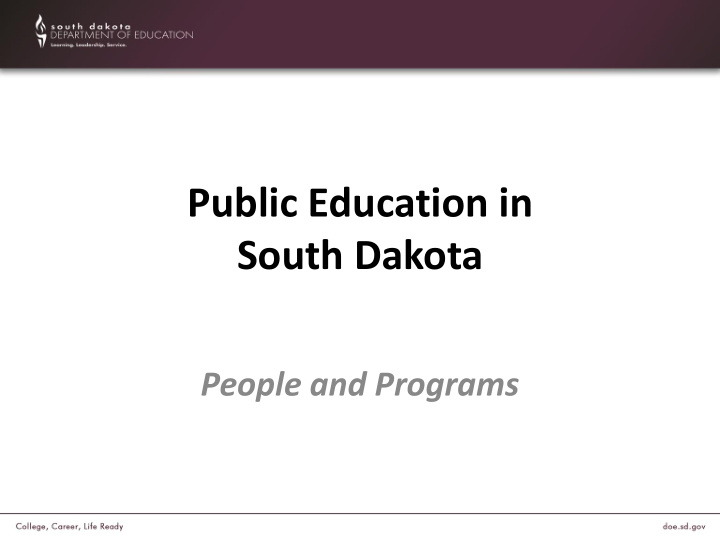



Public Education in South Dakota People and Programs
Number of districts 180 175 170 165 160 # districts 155 150 145 140 135 SY 2017-18 SY 2002-03
Number of schools 740 730 720 710 # schools 700 690 680 670 SY 2017-18 SY 2002-03
District size (Fall 2017 enrollment) 30 districts 40 districts 0-200 students 0-599 201-599 students 73.15% 600+ students 79 districts
Number of teachers (FTE) SY 2016-17 9,308.95 FTE Certified teachers
Teaching years of experience 0 years 1-3 years 0-10 years 4-5 years 47 % 6-10 years 11-15 years 11-25+ 16-20 years 53% 21-25 years 25+ years
Ethnicity of teaching force Asian Black Hispanic 97.2% Native American White White Multi-race
Teachers Rachel Schaefer, Elkton 2018 Teacher of Year
Teachers Mercia Schroeder, Plankinton
Teachers Sage Fast Dog, Todd County
Teachers Cathy Smith, Faith Dee Quinnett, Northwestern Area Ed Co-op
Number of administrators (FTE) SY 2016-17 538.20 FTE Superintendents, assistant superintendents, principals, assistant principals
Administrators David Swank, Rapid City
School Support • School counselors • Librarians • Paraprofessionals • Food service workers • Custodians • Bus drivers • Secretaries • School board members • Parents • Community partners
Number of students K-12 Fall census enrollment 135,000 134,000 133,000 133,861 132,000 131,000 132,520 130,000 130,963 129,000 128,000 129,772 128,294 127,000 126,000 125,000 2013 2014 2015 2016 2017
Number of students SY 2017-18 Two largest districts Rapid City: 13,655 Sioux Falls: 23,859 28% of student population
Ethnicity of students Fall 2017 Race/ethnicity # of students Asian 2,364 Black 4,170 Hispanic 7,944 Native American 14,807 Pacific Islander 150 White 99,147 Multiple Races 5,279
Ethnicity of students Fall 2017 Hispanic 5.93% Asian Native Black 11.06% Hispanic Native American Pacific Islander White White 74.07% Multiple Races
Students receiving free/reduced lunch Fall 2017 Free/reduced 37.31% Free/reduced Non-free/reduced
English learner students Fall 2017 Year # of students % of student population 2013 4,563 3.56% 2014 4,638 3.57% 2015 4,452 3.40% 2016 4,647 3.51% 2017 5,277 3.94%
Students receiving SPED services December Child Count Year # of students % of student population 2012 18,158 13.89% 2013 18,354 13.97% 2014 18,846 14.19% 2015 19,423 14.06% 2016 20,224 14.89%
How do students learn? Opportunities for students • Traditional learning environments • Customized or personalized learning • Distance learning • Special focus learning: • Career and technical education • Language immersion • Coding
How do students learn? Customized or personalized learning • Recognition that students learn at different rates and in different ways • Focus on quality of learning • Mastery of concepts vs. time/grade level as driver • Personalizing content, engaging students • Schools engaging in varying degrees • All grades to certain classrooms
How do students learn? Distance learning • South Dakota Virtual School • Variety of courses, taught by qualified professionals, aligned to state standards • Core content, advanced/AP courses, language courses, remedial courses • Delivery method: some fully online; some blended • Schools using DDN to share teachers, deliver courses
How do students learn? Special focus learning • Career and technical-focused • About 700 approved secondary CTE programs • Enrollment in CTE courses: 27,700+ (SY 2016-17) • Language immersion • Sonia Sotomayor Spanish Immersion, Sioux Falls • Coding • Anne Sullivan Elementary, Sioux Falls
How do students perform? Academic proficiency % Proficient Smarter Balanced Assessment 60.00% 50.00% 40.00% 30.00% 20.00% 10.00% 0.00% SY 2014-15 SY 2015-16 SY 2016-17 ELA Math
How do students perform? Academic growth % Meeting Growth Standard Smarter Balanced 58.00% 57.00% 56.00% 55.00% 54.00% 53.00% 52.00% 51.00% 50.00% 49.00% 48.00% SY 2015-16 SY 2016-17 ELA Math
How do students perform? Attendance School Year % meeting attendance benchmark 2014-15 79.66% 2015-16 80.23% 2016-17 79.32%
How do students perform? High school graduation 92.00% 90.00% 88.00% 86.00% 84.00% 82.00% 80.00% 78.00% SY 2014-15 SY 2015-16 SY 2016-17 4-Year Cohort HS Completion
How do students perform? College readiness % Meeting Benchmark: ACT, Accuplacer & Smarter Balanced 80.00% 70.00% 60.00% 50.00% 40.00% 30.00% 20.00% 10.00% 0.00% SY 2014-15 SY 2015-16 SY 2016-17 English Math
How do students perform? ACT Scores
How do students perform? NAEP Reading - Grade 4
How do students perform? NAEP Reading - Grade 8
How do students perform? NAEP Math - Grade 4
How do students perform? NAEP Math - Grade 8
How is state supporting learning? Blue Ribbon Education Package $46,000 $45,000 $44,000 $45,625 $43,000 8.8% $42,000 $41,940 $41,000 $40,000 SY 2015-16 SY 2016-17
How is state supporting learning? Statewide Mentoring Program 700 600 279 Mentors 500 400 Mentors New Teachers 300 154 Mentors 356 New Teachers 200 100 179 New Teachers 0 SY 2016-17 SY 2017-18
How is state supporting learning? • National Board Certification • Widely recognized professional certification • Funding for stipends reinstated • $1,000 state / $1,000 district for 5 years • Paraprofessional scholarship program
How is state supporting learning? School administrators • Principal Leadership Program • Partnership with School Administrators of SD • Aspiring Leaders Program • Partnership with TIE
How is state supporting learning? Opportunities for students • State’s low -cost dual credit program • College readiness program • Proactive admissions partnership • Native American Achievement Schools
How is state supporting learning? Opportunities for students • Workforce education grants • McIntosh – New Heavy Equipment Operator program
How is state supporting learning? Opportunities for students • Career Launch • Pilot with four districts: Brookings, Rapid City, Sioux Falls, Yankton • Career advising & business liaison services provided through DLR & DOE • Establish work-based learning opportunities for students
www.doe.sd.gov
Recommend
More recommend